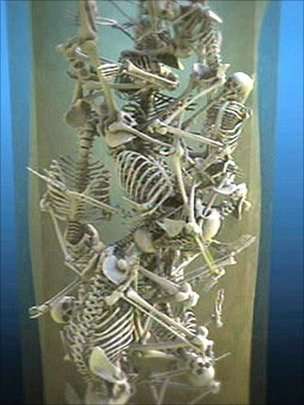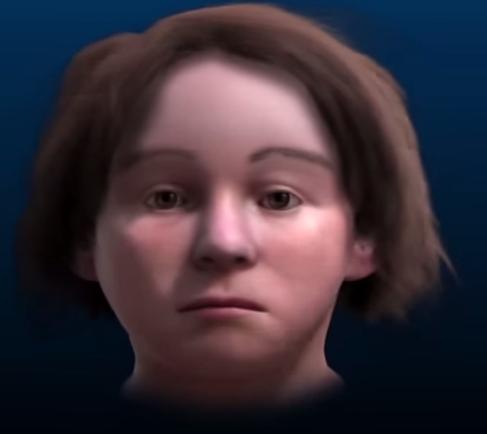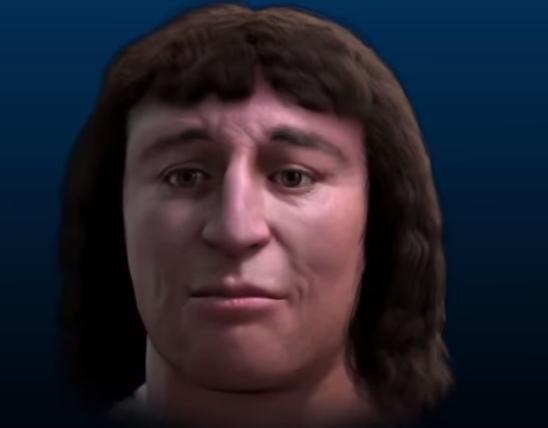Seventeen Bodies in a Well: A Norwich Mystery July 11, 2015
Author: Beach Combing | in : Medieval , trackbackThe picture above is a horrific one. The bodies of seventeen individuals, eleven of them children (the youngest two years of age) who were, at some point in the Middle Ages (dating 1150-1300), thrown down a well in the East Anglian town of Norwich. The bodies were discovered in 2004 and various years of careful research followed. However, a find this horrifying and this fascinating was bound to assert its own narrative and that happened in 2011 when Cold Case, a British television series looked into the affair and claimed that the bodies were victims of a pogrom. Here is a very powerful story: imagine parents being hurled down the well and being followed by their screaming children; imagine how long it would have taken to die… But, through all this there are serious doubts about the, let’s call it, ‘official’ story.
First doubt: were the seventeen alive? The original excavation report mentions four fractures on seventeen bodies: one greenstick, two healed and one possible; nothing suggesting injuries from a fall while alive. In fact, there is no evidence at all that they were thrown into a well while still breathing or that any had suffered the kind of violence that we might expect from a pogrom leading up to death, being beaten through the streets etc. Some mutterings about suicide during a pogrom are, meanwhile, simply bizarre. The children were thrown in last…
Second doubt: were the seventeen Jewish? The only ‘strong’ evidence for this claim is their DNA. Five of the bodies had retrievable DNA and these five came from the same family. The problem is proving that the DNA in question is ‘Jewish’. The five bodies were judged to have DNA ‘consistent’ with Ashkenazi Jews (30%), but that is DNA also found (though to a lesser extent) among the general European population (7%). Note that two other bodies had typical European DNA sequences.
Seventeen bodies, dead or alive, were thrown down a well: should we assume that the well was little used or dry? There were no signs of leprosy or tuberculosis on the skeletons, two diseases that leave marks. But then there are lots of other diseases that do not leave marks on bone. Why not, for example, some plague passing through the urban population? This would, according to that hypothesis, have been a messy burial by some neighbours who had to get dead bodies out of the way. Alternatively, we could be looking at some kind of act of mob violence, though, as noted above, mob violence might be expected to have shown up on the remains of the seventeen. There was a Jewish population in the city. The Jewish population had been ‘investigated’ for supposedly murdering a Christian child in 1144, William of Norwich: one of the first and best documented cases of the blood libel. In 1190 there is contemporary evidence of massacres against the Jews of Norwich: this was the year of perhaps the worst British pogrom, the deaths of 150 Jews in York.
But while archaeologists continue to scratch their heads, the rest of society has moved on. In 2014, after long negotiations, the local Jewish community took possession of the seventeen bodies and buried them in consecrated ground. Even during these burials there was an understanding that the bodies might not be Jewish but as Bishop David Gillett (previously of Bolton), who attended the ceremony, commented: ‘ Whatever the DNA research reveals, the discovery of the bones has raised awareness of some of the real injustices inflicted on the Jewish community in medieval times.’ This is the spirit in which a plaque has now been erected to their memory at the shopping mall, the Chapelfied Centre, where these dead or alive bodies were dropped down a well. It is artfully and perhaps sensibly ambiguous: particularly when it is remembered just how indifferent to historical facts many history plaques are.
It should be noted that while the proof that these were Jewish victims is circumstantial, there is a great deal of all too definite proofs from twelfth- and thirteenth-century Europe for the most bestial violence against Jewish innocents. There is, in short, plenty of blood to be washed from Europe’s collective hands whatever the circumstances behind the burial or murder of these seventeen.
The documentary is here:
11 July 2015: Southern Man writes: I’m sending you the documentary link [now put up, thanks]. The documentary is well made and manipulative, as all good documentaries are. But as you say the evidence is circumstantial. The progam states at the end ‘We can now state that at least five of the people in the well were Jewish’. This is a hypothesis, perhaps even a likely hypothesis, but not a certainty by any means. What you miss out on entirely above is the argument, I found convincing, that even plague burials involve Christian burial. Perhaps these were Jewish plague victims disposed of by the mob? I fear that the easier explanation is that of mass murder: as the forensic expert questions said ‘let’s hope they had their throats slit first’. Fascinating and horrible case. Just to make this more real I’m including some links of facial reconstructions of an adult and his son or daughter. I see the child with freckles…
21 July 2015: Sophie Cabot, who was a consulting archaeologist on that program kindly replied to an email.
‘I was featured (unpaid) in the History Cold Case program in my capacity as a local archaeologist with an interest in the period and – for whatever difference it makes, or should make – I’m also of Jewish heritage. It’s actually a relief to me to see an internet source taking such a balanced view of the available evidence, and looking at what can happen when a narrative is created for the purposes of television and not as part of academic discourse.
The short answer is no, we didn’t get more definitive DNA results – and barring a future funded project we probably won’t see any further study of the genetic material, but it’s important to realise that it might not be useful if we did. What we did get was a second interim report on the initial results, in which as I understand it the analyst withdrew entirely his suggestion that the gene found was related to known ‘Jewish markers’, so there is probably no reason to follow that line of enquirer much further.
That means that we have some dead people, in a well, which is just exactly what we had to start off with – the only move forward contributed by the DNA study at this point is that we know that of the three sampled individuals two were related, either as father and child or as uncle and nephew/niece. I understand that at least one skeleton had indication of violent assault, and we know that the bodies were intact and flexible when they went into the dry well – so not a result of burial ground clearance or similar – but as you’ve established we don’t have any indication of their being alive when deposited, we don’t know who they were, and we don’t know why they might have been killed or what led to their bodies being disposed of in such an unorthodox way. This is not by any means to say that they couldn’t have been Jews just that there is no particular reason, other than the creation of a dramatic story line, to assert that they were.
We also have a situation in which these seventeen (of nobody knows how many) sets of remains have now been de-accessioned from museum storage and buried in the Jewish section of a modern municipal cemetery. The decision to do this, and the creation of the carefully worded plaque you refer to, all happened between the two DNA reports and because of the level of public interest it wasn’t really possible to ‘turn the horses’ once it became apparent that there was no special justification for a Jewish identification.
On a personal note the period when we were dealing with this program in our office was one of the most challenging I have ever dealt with, personally and professionally. Perhaps the saddest part of the whole thing to me is just how readily the media and the public have accepted the narrative of an unknown anti-Semitic massacre in Norwich, as if it were the most natural thing in the world that people should do such things. When I have said this in public I have on occasions been attacked as a ‘revisionist’ or even a ‘denier’, as if I were subverting some established evidence, and not treated as an archaeologist hoping to establish a reasonable narrative from the known material. Public commentary – a good deal of which came to me personally because my name was widely published – has ranged from the far right to the ultra-Zionist, and included some deeply offensive material. I do feel that the producers had not expected, nor prepared for, the level of response or the hurt caused to many people by the narrative that they put forward as ‘settled’, or perhaps they would have taken more pains to explain the uncertainties and complexities inherent an any such investigation.’
I also asked Sophie two questions. Her answers follow.
First, are we sure it was a well? Was there any structure or was this just a deduction from the way the bodies were found? Yes, we are certain – it was a proper structure, but the top of it was damaged by the foundation works before the rest was excavated so it could have been deeper/contained further bodies, and we never saw the top to know how/if it was capped off.
Second, the chronology quoted was 1150-1300, is that fairly firm? Yes, that’s based on C14 dates from the bones, and the pottery from the site in general, so as firm as such dating gets – it can be considered reliable.
I also want to note that Alan West (a Norfolk archaeologist) confirmed that no DNA test came back from Mainz. Thanks to Alan and Sophie for their time.






